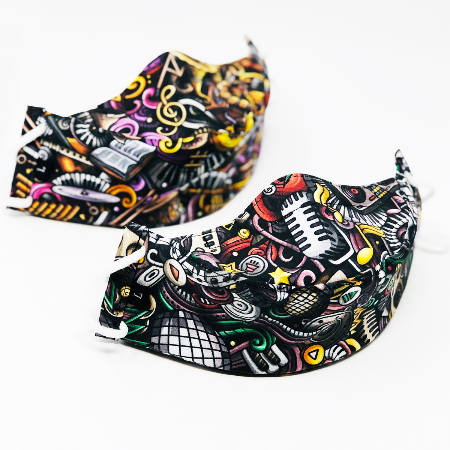
Masks for Singing: Helpful Links and Information
17 Sept 2021

17 September 2021
Since the early days of the pandemic, there has been a growing online community of choral singers, directors and sewers considering scientific research to develop the ideal mask for singing. Canadian singer and choral director Joan Fearnley has founded the Open Source Mask for Singers Project, creating a pattern for the optimal singers’ mask over a year ago, and uploading instructional videos to her YouTube channel about how to make these masks at home. She also hosts a popular and active Facebook Group called Masks for Performers that is a space for people to share their experiences in mask wearing and sewing, and swap mask patterns and ideas.
Scroll to the bottom of this article to find out where you can purchase masks for singers in New Zealand, including via the NZ Youth Choir website
How Many Layers, and What Fabric?
On the Choral Canada website Joan Fernley outlines some key points regarding mask-wearing in choirs, including the World Health Organization’s recommendation that masks be made of three layers. She also lists the optimal fabric selections for crafting personal singing masks, including a middle filtration layer of spunbound non-woven polypropylene, and inner/outer layers of Quilter’s cotton. Her most recent video outlines all the mask-making information:
You can watch more videos in that series by finding her YouTube channel playlist here.
How Can the Mask Fit When I Have to Move My Mouth a Lot?
Joan Fearnley also talks about the correct fit of a mask, stating that “it is always important to make sure a mask seals well around the face. Air must flow through the fabric and not around the mask and through the gaps.” Due to the larger jaw movement as a result of singing, masks for choirs need to be designed with extra fabric around the chin to accommodate these movements, so that the jaw can move without sacrificing the snug fit of the mask. Fearnley adds that this additional fabric also serves as a means of increasing the overall breathability of the mask.
Her video above also covers the issue of masks getting sucked into your mouth while inhaling to sing. Her secret is adding “semi-rigid elements such as boning, cable ties, crafting plastic mesh, or horsehair mesh” to keep the mask fabric away from the nose and mouth.
This article on makermask.org outlines Fearnley’s mask considerations when it comes to fit, structure, breathability, filtration, and acoustics, and is a good read.
What’s the best way to wash my mask?
The recommendations centre around the materials used – while cotton may withstand the settings of the washing machine and dryer, the middle polypropylene layer and structural material of choice are more fragile. Washing by hand will extend the life of the mask and bleach products should be avoided. Hand-wash with a gentle unscented detergent at the highest possible temperature allowed for the fabrics used in your mask, then rinse thoroughly, and hang to dry in a dry place – as damp masks can become breeding grounds for mould and bacteria.
Where Can I Read More about Masks for Singers?
We recommend having a look at the article “Constructing Masks for Singers” on makermask.org, where you can find links to numerous scientific studies on masks, learn more about the best fabrics to choose for each layer, see photos of the masks, and find out about the best methods of washing your masks.
Joan Fearnley’s YouTube channel is a good place to find a range of video tutorials on making singers’ masks.
This Choral Canada blog post outlines some research into mask layering for singers, including information on doubling up on blue disposable masks.
Where can I purchase singing masks for my choir?
The NZ Youth Choir are making 100% cotton masks to order, adapted from a design by Joan Fearnley with alterations by Anna Bowron. Find out more and order on the NZYC website
KBB Music are stocking masks for singers in three different sizes, and these can be ordered online from their website (specific measurements listed) in either small, medium, or large.
Award-winning New Zealand milliner Anél Heyman has followed Joan’s Fearnley’s pattern to make masks for singers in stylish black, with multi-coloured fabrics on the inside. Follow this link to find out more: https://anel-heyman-oqjk.rocketspark.co.nz/shop/product/542207/singers-mask–black/
N95, KN95, P2 and FFP2 masks may also work well for singing, but fit is crucial. Many off-the-shelf disposible masks do not have adjustable ear loops which can mean the mask slides down the nose when opening the mouth wide. Korean-style box masks are available from https://www.rpmasksnz.com but note that these do not have adjustable ear loops for smaller/narrower faces.
The Facebook group Masks for Performers offers a long list of mask stockists, including these websites below that ship. The NZCF does not endorse any one particular mask, but recognises that Joan Fearnley’s designs have been tested and follow health recommendations based on scientific studies.
